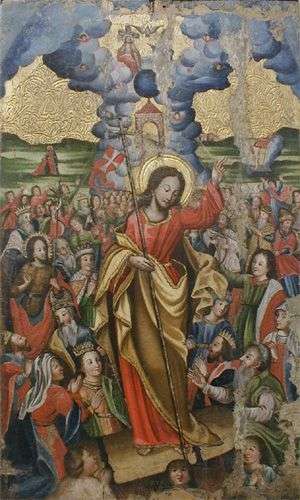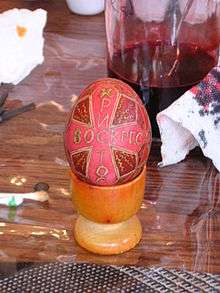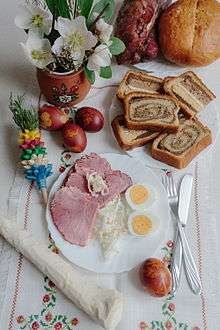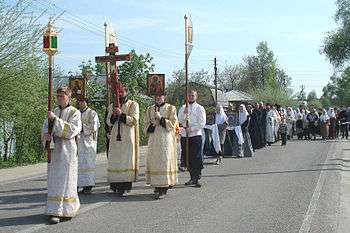Eastertide
Eastertide (also known as Eastertime or the Easter season) or Paschaltide (also known as Paschaltime or the Paschal season) is a festal season in the liturgical year of Christianity that focuses on celebrating the Resurrection of Jesus Christ. It begins on Easter Sunday, which initiates Easter Week in Western Christianity, and Bright Week in Eastern Christianity.[3] There are several Eastertide customs across the Christian world, including sunrise services, exclaiming the Paschal greeting, clipping the church,[4] and decorating Easter eggs, a symbol of the empty tomb.[1][5][6] The Easter lily, a symbol of the resurrection,[2][7] traditionally serve as the chancel flowers that decorate the chancel area of churches throughout Eastertide.[8] Other Eastertide customs include egg hunting, eating special Easter foods and watching Easter parades.[9][10]



| Christian liturgical year |
|---|
| Western |
| Eastern |
|
| East Syriac Rite |
|
In Western Christianity
Eastertide is the period of 50 days, spanning from Easter Sunday to Pentecost Sunday.[11] It is celebrated as a single joyful feast, called the "great Lord's Day".[12] Each Sunday of the season is treated as a Sunday of Easter. In some traditions, Easter Sunday is the first Sunday of Eastertide and the following Sunday (Low Sunday) is the second Sunday of Eastertide and so on;[13] in other traditions, following the Sunday of the Resurrection, they are named Second Sunday of Easter, Third Sunday of Easter, etc. up to the Seventh Sunday of Easter, concluding with Pentecost Sunday.[14]
Easter Sunday and Pentecost correspond to pre-existing Jewish feasts: The first day of Pesach (פסח) and the holiday of Shavu'ot (שבועות). In the Jewish tradition, the 49 days between these holidays are known as Counting of the Omer (ספירת העומר).[15]
The first eight days constitute the Octave of Easter and are celebrated as solemnities of the Lord.[16]
Since 2000, the Second Sunday of Easter is also called Divine Mercy Sunday. The name "Low Sunday" for this Sunday, once common in English, is now used mainly in the Church of England.
The solemnity of the Ascension of the Lord is celebrated on the 40th day of Eastertide (a Thursday), except in countries where it is not a Holy Day of Obligation. In such countries it is celebrated on the following Sunday (the 43rd day of Eastertide).[17] The nine days from that feast until the Saturday before Pentecost (inclusive) are days of preparation for the Holy Spirit the Paraclete,[18] which inspired the form of prayer called a novena.
Before the 1969 revision of the calendar, the Sundays were called First Sunday after Easter, Second Sunday after Easter, etc. The Sunday preceding the feast of the Ascension of the Lord was sometimes, although not officially, called Rogation Sunday, and when the Ascension had an octave, the following Sunday was called Sunday within the Octave of the Ascension.[19] When this octave was abolished in 1955, it was called Sunday after the Ascension.[20] Pentecost was followed by an octave, which some reckoned as part of Eastertide.
When the Anglican and Lutheran churches implemented their own calendar and lectionary reforms in 1976, they adopted the same shortened definition of the Easter season as the Roman Catholic Church had promulgated six years earlier. In the Church of England, the Easter season begins with the Easter Vigil and ends after Evening Prayer (or Night Prayer) on the Day of Pentecost. Some Anglican provinces continue to label the Sundays between Easter and the Ascension "Sundays After Easter" rather than "Sundays of Easter"; others, such as the Church of England and ECUSA, use the term "Sundays of Easter".
Paschal Tide is a season of joy. The colour for the Office de tempore is white; the Te Deum and Gloria are recited every day even in the ferial Office. On Sundays the "Asperges" is replaced by the "Vidi Aquam" which recalls the solemn baptism of Easter eve. There is no feast day from Easter until Ascension. The Armenians during this period do away even with the abstinence on Fridays. Prayers are said standing, not kneeling. Instead of the "Angelus" the "Regina Caeli" is recited. From Easter to Ascension many churches, about the tenth century, said only one Nocturn at Matins; even some particular churches in the city of Rome adopted this custom from the Teutons (Bäumer, "Gesch. des Breviers", 312). Pope Gregory VII limited this privilege to the week of Easter and of Pentecost. Some dioceses in Germany however, retained it far into the nineteenth century for 40 days after Easter. In every Nocturn the three psalms are said under one antiphon. The Alleluia appears as an independent antiphon; an Alleluia is also added to all the antiphons, responsories and versicles, except to the versicles of the preces at Prime and Compline. Instead of the "suffragia sanctorum" in the semidouble and ferial Offices, a commemoration of the Holy Cross is used. The iambic hymns have a special Easter doxology.
The feasts of the holy Apostles and martyrs have their own commune from Easter to Pentecost. At Mass the Alleluia is added to the Introit, Offertory and Communion; in place of the Gradual two Alleluias are sung followed by two verses, each with an Alleluia; there is also a special Preface for Paschal Time.
Paschal Tide was the period during which every member of the faithful who has attained the year of discretion was bound by the positive law of the Church to receive Holy Communion (Easter duty). During the early Middle Ages from the time of the Synod of Agde (508), it was customary to receive Holy Communion at least three times a year—Christmas, Easter and Pentecost. A positive precept was issued by the Fourth Lateran Council (1215) and confirmed by the Council of Trent (Sess. XIII, can. ix). According to these decrees the faithful of either sex, after coming to the age of discretion, must receive at least at Easter the Sacrament of the Eucharist (unless by the advice of the parish priest they abstain for a while). Otherwise during life they are to be prevented from entering the church and when dead are to be denied Christian burial. The paschal precept is to be fulfilled in one's parish church.
Although the precept of the Fourth Lateran to confess to the parish priest fell into disuse and permission was given to confess anywhere, the precept of receiving Easter Communion in the parish church was still in force where there are canonically-erected parishes.
The term Paschal Tide was usually interpreted to mean the two weeks between Palm and Low Sundays (Synod of Avignon, 1337); by St. Antonine of Florence it was restricted to Easter Sunday, Monday and Tuesday; by Angelo da Chiavasso it was defined as the period from Maundy Thursday to Low Sunday. Eugene IV, 8 July 1440, authoritatively interpreted it to mean the two weeks between Palm and Low Sundays.[21]
In later centuries the time has been variously extended: at Naples from Palm Sunday to Ascension; at Palermo from Ash Wednesday to Low Sunday. In Germany, at an early date, the second Sunday after Easter terminated Paschal Tide, for which reason it was called "Predigerkirchweih", because the hard Easter labour was over, or "Buch Sunday", the obstinate sinners putting off the fulfillment of the precept to the last day. In the United States upon petition of the Fathers of the First Provincial Council of Baltimore Paschal Tide was extended by Pius VIII to the period from the first Sunday in Lent to Trinity Sunday (II Plen. Coun. Balt., n. 257); in Canada the duration of the Paschal Tide is the same as in the United States. In England it lasts from Ash Wednesday until Low Sunday; in Ireland from Ash Wednesday until the octave of SS. Peter and Paul, 6 July.[22]
Liturgical aspects
This tide was called by the older liturgists "Quinquagesima paschalis" or "Quin. laetitiae". The octave of Easter which closes after Saturday has its own peculiar Office. Since this octave is part and complement of the Easter Solemnity, Paschal Tide in the liturgical books commences with the First Vespers of Low Sunday and ends before the First Vespers of Trinity Sunday. On Easter Sunday the Armenian Church keeps the Commemoration of All the Faithful Departed and on Saturday of Easter Week the Decollation of St. John. The Orthodox (Greek) Church celebrates on Friday of Easter Week the feast of Our Lady, the Living Fountain (shrine at Constantinople).
The Sundays from Easter to Ascension Day, besides being called the First, Second (etc.) Sunday in Easteride or after Easter Sunday, have their own peculiar titles.[13]
First Sunday
Second Sunday
The second is the Feast of Mercy[23][24], also known as "Dominica in albis", or Low Sunday. In the Dioceses of Portugal and Brazil (also in the ecclesiastical province of St. Louis, Mo.) on the Monday after Low Sunday is celebrated the feast of the Joys or Exultation of Mary at the Resurrection of her Son (double of the second class). The Russians, on Tuesday of this week, celebrating Radonitsa, go in procession to the cemeteries and place Easter eggs on the graves[25]
Third Sunday
In the Latin Church the third Sunday is called from its Gospel the Sunday of the Good Shepherd and from the Introit "Misericordias Domini"; in many dioceses (Seville, also with the order of the Capuchins) it is called the feast of Our Lady Mother of the Good Shepherd (double second class); at Jerusalem and in the churches of the Franciscans it is called the feast of the Holy Sepulchre of Christ; in the Greek Church it is called ion myrophoron (Sunday of the women who brought ointments to the sepulchre of Christ); the Armenians celebrate on this Sunday the dedication of the first Christian church on Mount Sion.
Fourth Sunday
The fourth Sunday of Eastertide is called from the Introit "Jubilate";[26] the Latin Church has assigned to it the feast of the Patronage of St. Joseph (double second class); the Greeks call it the Sunday of the Paralytic, from its Gospel.
Fifth Sunday
The Oriental Churches on Wednesday after the third Sunday celebrate with a very solemn Office and an octave, the Mesopentekoste, the completion of the first half of Paschal Tide; it is the feast of the manifestation of the Messiah, the victory of Christ and the Church over Judaism ["Zeitschrift für katholische Theologie" (1895), 169-177]; the Slav nations in this day have a solemn procession and benediction of their rivers.[27] The fifth Sunday is called Cantate Sunday;[28] by the Orientals it is called Sunday of the Samaritan Woman.
Sixth Sunday
The sixth Sunday, "Vocem jucunditatis" in the Orient, Sunday of the Man Born Blind. In the Latin Church follow the Rogation Days; in the Greek Church on Tuesday is kept the apodosis or conclusion of the feast of Easter. The Greeks sing the Canons of Easter up to this Tuesday in the same manner as during Easter Week, whilst in the Latin Church the specific Easter Office terminates on Saturday following the feast. Thursday is the feast of the Ascension. The Friday of this week, in Germany, is called "Witterfreitag"; the fields are blessed against frost and thunderstorms.
Seventh Sunday
Sunday within the octave of Ascension is called "Exaudi" from the Introit; in some dioceses it is called Feast of Our Lady, Queen of the Apostles (double major) or of the Cenacle (Charleston and Savannah, first class); in Rome it was called Sunday of the Roses ("Pascha rosarum" or "rosatum"), since in the Pantheon rose-leaves were thrown from the rotunda into the church; in the Greek and Russian Churches it is the feast of the 318 Fathers of the first Nicene Council; the Armenians call it the "second feast of the flowers", a repetition of Palm Sunday. By older liturgists the week before Pentecost is called "Hebdomada expectationis", week of the expectation of the Holy Ghost. On the Vigil of Pentecost the baptismal water is blessed in the Latin Church; in the Oriental Churches it this Saturday is the psychosabbaton (All Soul's Day); on this day the Greeks bless wheat cakes and have processions to the cemeteries.
In Eastern Christianity

In the Eastern Orthodox Church, Pascha begins on Easter Sunday at Matins which is normally celebrated at midnight and continues for forty days through the ninth hour on the day before the Ascension.
See also
- Bright Week
- Embertides
- Papal mozzetta
- Paschal Cycle
- Pentecostarion
References
- Anne Jordan (5 April 2000). Christianity. Nelson Thornes.
Easter eggs are used as a Christian symbol to represent the empty tomb. The outside of the egg looks dead but inside there is new life, which is going to break out. The Easter egg is a reminder that Jesus will rise from His tomb and bring new life. Orthodox Christians dye boiled eggs red to make red Easter eggs that represent the blood of Christ shed for the sins of the world.
- Collins, Cynthia (19 April 2014). "Easter Lily Tradition and History". The Guardian. Retrieved 20 April 2014.
The Easter Lily is symbolic of the resurrection of Jesus Christ. Churches of all denominations, large and small, are filled with floral arrangements of these white flowers with their trumpet-like shape on Easter morning.
- "CATHOLIC ENCYCLOPEDIA: Paschal Tide". Catholic Encyclopedia. May 2013. Retrieved 26 May 2013.
- Simpson, Jacqueline; Roud, Steve (2003). "clipping the church". Oxford Reference. Oxford University Press. doi:10.1093/acref/9780198607663.001.0001. ISBN 9780198607663. Retrieved 30 March 2013.
- The Guardian, Volume 29. H. Harbaugh. 1878.
Just so, on that first Easter morning, Jesus came to life and walked out of the tomb, and left it, as it were, an empty shell. Just so, too, when the Christian dies, the body is left in the grave, an empty shell, but the soul takes wings and flies away to be with God. Thus you see that though an egg seems to be as dead as a sone, yet it really has life in it; and also it is like Christ's dead body, which was raised to life again. This is the reason we use eggs on Easter. (In olden times they used to color the eggs red, so as to show the kind of death by which Christ died,-a bloody death.)
- Gordon Geddes, Jane Griffiths (22 January 2002). Christian belief and practice. Heinemann. ISBN 9780435306915.
Red eggs are given to Orthodox Christians after the Easter Liturgy. They crack their eggs against each other's. The cracking of the eggs symbolizes a wish to break away from the bonds of sin and misery and enter the new life issuing from Christ's resurrection.
- Schell, Stanley (1916). Easter Celebrations. Werner & Company. p. 84.
We associate the lily with Easter, as pre-eminently the symbol of the Resurrection.
- Luther League Review: 1936-1937. Luther League of America. 1936.
- Vicki K. Black (1 July 2004). The Church Standard, Volume 74. Church Publishing, Inc. ISBN 9780819225757.
In parts of Europe, the eggs were dyed red and were then cracked together when people exchanged Easter greetings. Many congregations today continue to have Easter egg hunts for the children after the services on Easter Day.
- Davis, David (20 April 2014). "Easter Traditions Explained". CBS News. Retrieved 20 April 2014.
- Normae Universales de Anno Liturgico et de Calendario (NUALC), 22
- Saint Athanasius, Epist. fest. I: Patrologia Graeca 26, 1366
- "Saints Will Arise: So which Sunday in Eastertide is it? Take your pick!". Saints Will Arise. 13 April 2013. Retrieved 2 May 2019.
- NUALC, 23
- Deuteronomy 16:1-10
- NUALC, 24
- NUALC, 25
- NUALC, 26
- Missale Romanum, 1920 typical edition
- 1962 Roman Missal
- G. Allmang, "Kölner Pastoralblatt" (Nov., 1910) 327 sq.
- O'Kane "Rubrics of the Roman Ritual", n. 737; Slater, "Moral Theology" 578, 599
- "Divine Mercy Library". Marian Fathers of the Immaculate Conception of the B.V.M. Retrieved 2 May 2019.
The English translation says that "in the Roman Missal, after the title 'Second Sunday of Easter' shall be added the appellation 'or Divine Mercy Sunday.'"
- The Congregation of the Sisters of Our Lady of Mercy
- Maltzew, "Fasten-und Blumen-Triodion" (Berlin, 1899), 791
- Fenker, Aaron. "Jubilate – Rejoice!". Higher Things. Retrieved 2 May 2019.
Today is Jubilate Sunday, the fourth Sunday of Easter. Jubilate comes from the Latin Introit for today – “Make a joyful noise.”
- Nilles, "Kal." II, 361
- "Fifth Sunday of Easter". Saint Augustine's House Lutheran Monastery. 14 May 2017. Retrieved 2 May 2019.
Fifth Sunday of Easter – “Cantate Sunday” – Sing to the Lord a new song, alleluia; for the Lord has accomplished wondrous deeds, alleluia; he has revealed his justice in the sight of the Gentiles, alleluia, alleluia. Ps. His right hand and his holy arm have given him victory. ~Introit
